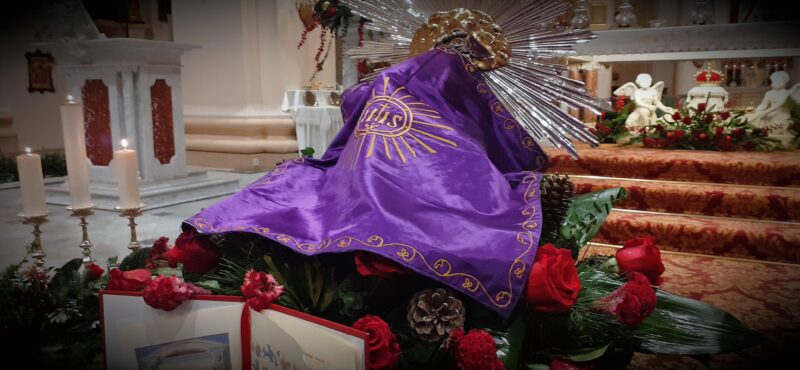In our parish, we have a tradition of covering the statue of the infant Jesus with a purple veil on the feast of the Holy Innocent, which is celebrated on 28 December. The veil is a square drape according to the liturgical colour and used for covering the chalice—a liturgical norm which vanished almost completely. The purple colour symbolises the sorrow for the lost lives of these babies. In fact, until 1961, the liturgical colour for this feast was purple, eventually substituted with the red of the martyrs, as is still customary today.
In spite of the fact that this tradition has been going on for some time now, people are curious and ask why the infant Jesus is covered. Of course, the answer reply is: “Well, so that Herod won’t find him.” Although some of the people are intrigued, others think that you’re taking them for a ride—and they’re not completely mistaken.
This symbolic gesture somewhat reminds me of the babies’ stages of development when, at first, they still haven’t acquired the ability to understand that an object still exists even though it cannot be seen. And that is why, when we’re playing with very young babies, we sometimes hide our face or some toy and start asking, “Where is it, eh? Where did he go?” and they start turning their eyes around. But when you uncover your face or show them the toy, they immediately smile and laugh.
Surely, Herod was well beyond this stage of development scientifically know as object permanence, so much so that he killed a lot of people, including some of his own children to eliminate any presumed threat to his power.
Ma nafx intix se tgħattih il-Bambin jew le. Wara kollox, kulma hi tradizzjoni mingħajr l-ebda tifsira teoloġika profonda. Imma jalla ma tgħattihx f’ħajtek lil Ġesù, mhux għax tibża’ li l-Erodijiet ta’ żmienna jsibuh, imma għax tittama li ma jarakx tgħix ħajtek kif jogħġob lilek u mhux kif jogħġob lilu.
This tradition may be judged as ridiculous or just sweet. But I think that, like Herod who never managed to see Jesus, we too tend to act like babies without any sense of object permanence—in this case the sense of permanence of Jesus … when we go out of church and return back to our normal life, as if nothing has happened … when we don’t allow our conscientious to be enlightened by the Gospel and end up justifies anything … when we stop at our fascination with the infant Jesus and avoid looking at an adult Jesus who is assertive, servant and crucified, as though the babe of Betlehem and the crucified hanging outside the walls of Jerusalem aren’t the one and the same Son of God who became man to redeem us.
I don’t know if you’re going to cover up the statue of the infant Jesus or not. After all, it is just a tradition without any profound theological meaning. But I do hope for you and me that we don’t cover Jesus in our life, not out of fear from the many Herods of our times, but because we hope that He doesn’t see us living your life according to our likes and not according to his will.




